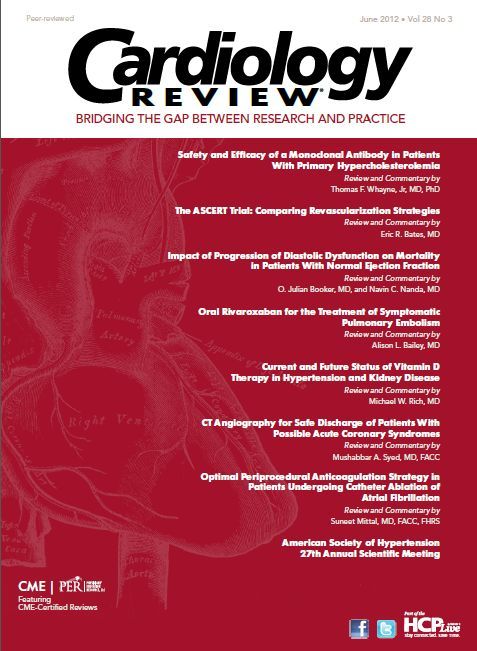Publication
Article
Cardiology Review® Online
CT Angiography for Safe Discharge of Patients With Possible Acute Coronary Syndromes

Mushabbar A. Syed, MD, FACC
Review
Litt HI, Gatsonis C, Snyder B, et al. CT angiography for safe discharge of patients with possible acute

coronary syndromes. N Engl J Med. 2012;366:1393-1403.
C
oronary computed tomographic angiography (CCTA) is a noninvasive test with excellent negative predictive value (NPV) to rule out the presence of coronary artery disease (CAD). Initial studies of CCTA in the emergency department (ED) have shown excellent prognostic value with minimal or no CAD; however, these studies were not large enough to test a CCTA-based clinical strategy of diagnostic testing and patient disposition from the ED.
Study Design
This was a prospective, randomized, controlled clinical trial comparing CCTA- based strategy with traditional care for evaluating low- to intermediate-risk patients presenting to the ED with possible acute coronary syndrome (ACS). The investigators hypothesized that patients without clinically significant CAD on CCTA (<50% stenosis) will have a less than 1% 30-day event rate of cardiac death or myocardial infarction (MI). The primary aim of the trial was to evaluate the safety of a CCTA-based strategy with 30-day event rate of cardiac death or MI. Secondary aims included rate of discharge from the ED, index visit length of stay, and the 30-day rates of death, MI, revascularization, and resource utilization in the CCTA group compared with the traditional strategy group.

Patients 30 years or older with possible ACS were enrolled from 5 ED sites or observation units. Patients had presentation ECG without evidence of acute ischemia and an initial Thrombolysis in Myocardial Infarction (TIMI) risk score of 0 to 2. Patients were excluded if they had non-cardiac chest pain, a coexisting condition requiring
admission, previously normal CCTA or invasive angiography in the previous year, and standard contraindications to CCTA, including a creatinine
clearance of less than 60 mL per minute.
Patients underwent computer-based randomization in a 2:1 ratio to CCTA or to traditional care. In the CCTA group, the first evaluation after randomization was CCTA. In the traditional group, the patient’s treating physician decided which tests, if any, were to be performed. CCTA was performed on a 64-slice or greater multidetector CT scanner and included calcium scoring and contrast-enhanced coronary CTA. β-blockers and nitroglycerin were used to control heart rate and dilate coronary arteries. Readers were required to meet the criteria for level-3 cardiac CT training. Coronary stenosis was quantified as <50%, 50% to 69%, or >70%. Discharge from the ED in the CCTA group required 2 negative troponin levels obtained 90 to 180 minutes apart and minimal or no CAD (<50% stenosis). Thirty-day follow-up included phone interview and review of any pertinent records.
The study was adequately powered. Comparisons between CCTA and traditional care groups were made by intention-to-treat analysis. Between July 2009 and November
2011, 1392 patients were enrolled. After the withdrawal of 22 patients (mostly due to renal insufficiency), 908 patients were randomized to CCTA and 462 patients to traditional care. Mean age was around 50 years, 53% were female, and 59% were black, with very few Asians, Hispanics, or other minority ethnic groups. There were no significant differences in baseline characteristics between the 2 groups.
CCTA was performed in 84% of the CCTA-based strategy group; of these, 83% had minimal or no coronary disease, 10% had >50% stenosis, and 6%were indeterminate. Stress testing was performed in 124 (14%) patients in the CCTA group and was negative in 79% and indeterminate in 9% of patients. Invasive coronary angiography was performed in 37 (4%) patients; 28 patients were found to have >50% coronary stenosis. In the traditional care group, 295 patients (64%) underwent diagnostic testing, usually a stress test mostly with imaging (258 patients). Of these, 6% were found to have reversible ischemia. CCTA was performed in 26 patients and invasive angiography in 18 patients; 8 patients were found to have >50% coronary stenosis. A total of 167 patients (36%) did not undergo any diagnostic
testing.
None of the negative CCTA patients died or had an MI within 30 days after presentation. There were also no deaths in the traditional care group. Both groups had a 1% rate of MI but CCTA had a higher trend for revascularization, 3% versus 1% for traditional care. There were no significant differences between the 2 groups for safety end points. Patients in the CCTA group were more likely to be discharged from the ED (49.6% versus 22.7%) and had a shorter length of stay. CAD was more often diagnosed in the CCTA group than the traditional care group (9% versus 3.5%). Over the course of 30 days after presentation, there was no difference between the 2 groups in the use of invasive angiography, likelihood of repeat ED visit, hospitalization, or cardiologist office visit. The authors concluded that in low- to intermediate-risk patients presenting to the ED with possible ACS, CCTA-based strategy is as safe as traditional care, and more efficient, with higher rates of ED discharge and reduced length of stay.
References
1. Pitts SR, Niska RW, Xu J, Burt CW. National Hospital Ambulatory Medical Care Survey: 2006 emergency department summary. Natl Health Stat Report. 2008;7:1-38.
2. Amsterdam EA, Kirk JD, Bluemke DA, et al; on behalf of the American Heart Association Exercise, Cardiac Rehabilitation, and Prevention Committee of the Council on
Clinical Cardiology, Council on Cardiovascular Nursing, and Interdisciplinary Council on Quality of Care and Outcomes Research. Testing of low-risk patients presenting to the emergency department with chest pain: a scientific statement from the American Heart Association. Circulation. 2010;122:1756-1776.
3. Braunwald E, Antman EM, Beasley JW, et al. ACC/AHA 2002 guideline update for the management of patients with unstable angina and non-ST-segment elevation myocardial infarction: a report of the American College of Cardiology/American Heart Association Task Force on Practice Guidelines (Committee on the Management of Patients With Unstable Angina). Available at: http://www.acc.org/clinical/guidelines/unstable/unstable.pdf.Published 2002. Accessed April 23, 2012.
4. Hoffmann U, Bamberg F. Is computed tomography coronary angiography the most accurate and effective noninvasive imaging tool for evaluating patients presenting with chest pain in the emergency department? CT coronary angiography is the most accurate and noninvasive imaging tool to evaluate patients presenting with chest pain to the emergency department. Circ Cardiovasc Imaging. 2009;2;251-263.
5. Laudon DA, Vukov LF, Breen JF, Rumberger JA, Wollan PC, Sheedy PF II. Use of electron-beam computed tomography in the evaluation of chest pain patients in
the emergency department. Ann Emerg Med.1999;33:15-21.
6. Goldstein JA, Gallagher MJ, O’Neill WW, Ross MA, O’Neil BJ, Raff GL. A randomized controlled trial of multi-slice coronary computed tomography for evaluation of acute
chest pain. J Am Coll Cardiol. 2007;49:863-871.
7. Hoffman U, Bamberg F, Chae CU, et al. Coronary computed tomography angiography for early triage of patients with acute chest pain: the ROMICAT (Rule Out Myocardial Infarction using Computer Assisted Tomography) trial. J Am Coll Cardiol. 2009;53:1642—1650.
8. Goldstein JA, Chinnaiyan KM, Abidov A, et al. The CT-STAT (coronary computed tomographic angiography for systematic triage of acute chest pain patients to treatment) Trial. J Am Coll Cardiol. 2011;58;1414-1422.
9. Hollander JE, Chang AM, Shofer FS, et al. One-year outcomes following coronary computerized tomographic angiography for evaluation of emergency department patients with potential acute coronary syndrome. Acad Emerg Med. 2009;16:693-698. 10. Litt HI, Gatsonis C, Snyder B, et al. CT angiography for safe discharge of patients with possible acute coronary syndromes. N Engl J Med. 2012;366:1393-1403.
Commentary
CT Angiography for Patients WithPossible ACS
More than 8 million people present every year with chest pain to the ED in the United States.1 Fewer than 5% have ST-segment elevation myocardial infarction (STEMI) and 25% have non-STEMI acute coronary syndrome (ACS).2 Several riskstratification strategies have been proposed focusing on identification of patients who can be safely sent home from the ED. The American Heart Association (AHA) recommends an initial clinical risk assessment for the probability of ACS based on history, physical examination, serial ECG, and cardiac biomarkers.3 The AHA scientific statement emphasizes that the primary goal of evaluation of these patients in the acute setting is accurate risk stratification by exclusion of ACS and other serious conditions, rather than detection of CAD. The current standard-of-care (SOC) strategy is time consuming, usually requiring 12 to 24 hours of observation and diagnostic testing. An alternative evaluation protocol that could be applied in most ED settings—and completed more
rapidly, thus avoiding a lengthy ED stay and permitting safe patient discharge from the ED—would have great clinical value. CCTA has evolved as an excellent noninvasive diagnostic tool for the detection of significant CAD. In this regard, several single-center and a few multicenter studies have documented excellent sensitivity and negative predictive value (NPV) with moderate to good specificity and positive predictive value.4 Earlier studies in patients with acute chest pain in the ED were performed
with non-contrast-enhanced CT imaging of coronary artery calcium (CAC). These studies reported excellent NPV of 99% to 100% for ACS with no or minimal CAC but limited positive predictive value in the presence of CAC.5
Single center and multicenter studies of contrastenhanced CCTA in ED acute chest pain patients have shown significant reductions in diagnostic time and cost for excluding ACS while maintaining high sensitivity and NPV.6-8 There have been no significant differences in major adverse cardiac events between CCTA and SOC groups over short- or long-term follow-up.8,9 In general, these studies included patients at low risk of ACS, normal or non-diagnostic ECG, normal cardiac
biomarkers, and no contraindications to CCTA.
The current study by Litt et al adds to a large body of research on CCTA-based strategy in the evaluation of low- to intermediate-risk chest pain patients in the ED.10 The CCTA-based strategy was as safe as traditional stress testing—based strategy with shorter length of stay and higher rates of discharge from the ED. Interestingly,
there was no difference in the downstream resource utilization between the 2 groups. The authors didn’t report estimated radiation doses for CCTA or nuclear MPI and also didn’t provide cost differences between the 2 strategies. CCTAs were analyzed by highly expert level—3–trained physicians, which may limit the generalizability of results in a community setting.
Based on the currently available evidence, a CCTAbased strategy is a reasonable alternative to traditional stress testing in low- to intermediate-risk acute chest
pain patients who don’t have contraindications to CCTA and when the studies are read by expert readers. Patients suitable for early discharge based on CCTA
results should have a nonischemic ECG and 2 sets of negative cardiac biomarkers. Standard CCTA contraindications include atrial fibrillation or irregular rhythm, renal insufficiency, BMI ≥40 kg/m2, contrast allergy, or contraindications to β-blocker use. A finding of normal or minimal disease in coronary arteries will likely obviate the need for additional testing and speed patient discharge from the ED with a good short-term prognosis. However, the presence of an intermediate degree of coronary artery stenosis will likely require further investigation with either stress testing or invasive coronary angiography or both. Whether patient outcomes are ultimately improved by adopting the CCTA-based strategy in the ED will require further investigation, optimally by randomized trials with adequate sample size.
About the Author
Mushabbar A. Syed, MD, FACC, is director of cardiovascular imaging and associate professor of medicine (cardiology) and radiology at Loyola University of Chicago’s Stritch School of Medicine. He received his MD from King Edward Medical College, Lahore, Pakistan, and completed residencies in Pakistan, Great Britain, and at Henry Ford Hospital in Detroit, MI, where he completed fellowships in cardiology and echocardiography. He also completed a fellowship in cardiovascular MRI at the National Institutes of Health. His areas of interest include cardiovascular imaging, adult congenital heart disease, and coronary artery disease.
